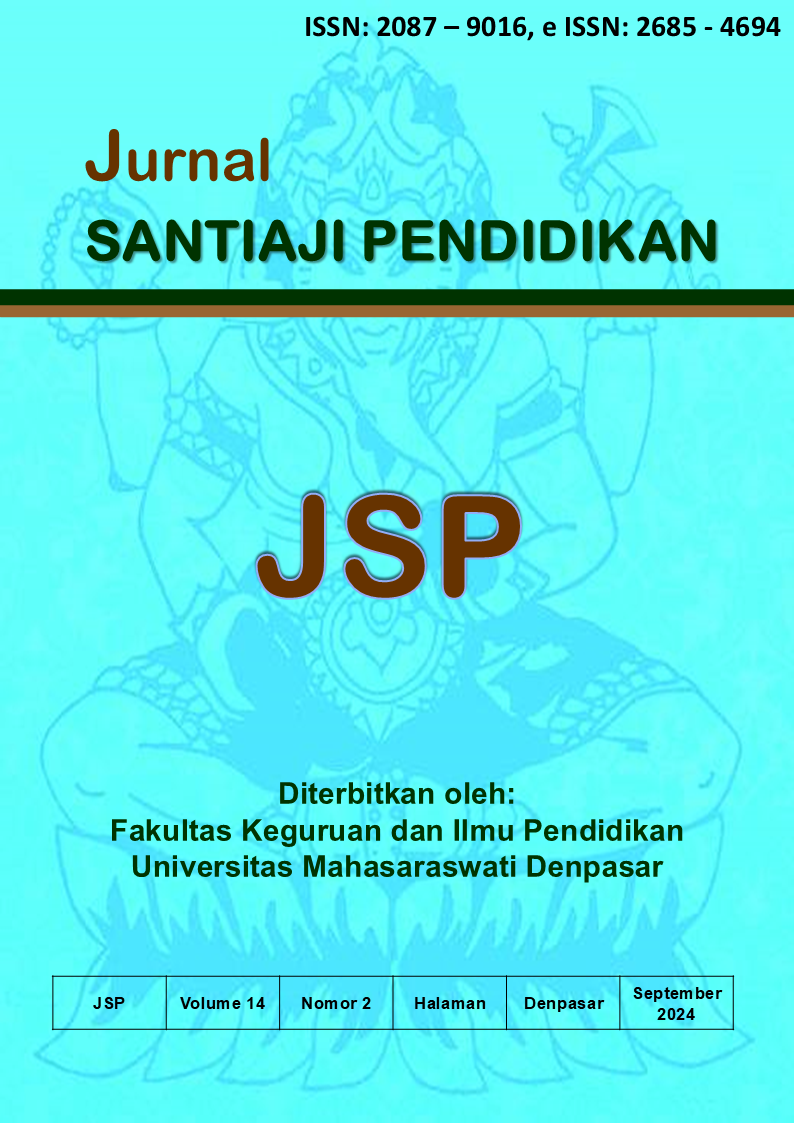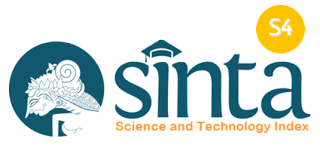CONTEXTUAL DISTANCE TEACHING TO IMPROVE TOURIST DRIVERS' ENGLISH LANGUAGE EXPRESSION
DOI:
https://doi.org/10.36733/jsp.v14i2.9923Keywords:
Distance Teaching, Contextual Teaching, English ExpressionAbstract
This study aimed to assess the effectiveness of Contextual Distance Teaching (CDT) in improving driver’s English language expression and enhancing motivation, while also evaluating its significant influence on their English proficiency. Utilizing an action research approach conducted via the WhatsApp online platform, this study engaged 10 tourist drivers associated with the Bali Transport group, aged between 22 and 50. The study comprised two cycles, each consisting of three sessions. Data collection involved administering tests and questionnaires, including pretest, post-test 1, and post-test 2. Analysis was conducted using descriptive statistics and paired sample t-tests. The initial findings indicate that CDT effectively enhances the language expression of drivers in service-related contexts. The average pretest score, initially categorized as "poor" at 39, improved to 65 in post-test 1 and further increased to 75.8 in post-test 2, now categorized as "fair.", The main score of the questionnaire was 4.4 of 0-5 Likert scale implying the drivers had positive motivation and perception on the strategy apllied. The second statistic finding indicated a significant difference in the mean between the pre-test (Sig. and the post-test 1 (0.000 < 0.05) and post-test 2 (0.000 < 0.05). This study suggests that the implementation of CBT has a positive influence on reducing the number of language expression errors made by drivers as adult learners, leading to better English proficiency.
Downloads
References
Al-Arimi, A. M. A.-K. (2014). Distance Learning. Procedia - Social and Behavioral Sciences, 152, 82–88. https://doi.org/10.1016/j.sbspro.2014.09.159
Anderson, T., & Dron, J. (2011). Three Generations of Distance Education Pedagogy. International Review of Research in Open and Distributed Learning, 12(3), 80–97. https://doi.org/10.19173/irrodl.v12i3.890
Atmawijaya, T. D. (2018). Pengaruh Penerapan Metode Contextual Teaching And Learning Dalam Pengajaran Kosakata Bahasa Inggris Siswa Kelas Xi Di Sma Negeri 33 Jakarta [The Effect Of Implementing Contextual Teaching And Learning On Teaching English Vocabulary In Grade 11 At Senior H. Polyglot: Jurnal Ilmiah, 14(2), 179–198. https://doi.org/10.19166/pji.v14i2.1045
Bušelić, M. (2012). Distance Learning–concepts and contributions. Oeconomica Jadertina, 2(1), 23–34.
Catalano, A. (2015). The Effect of a Situated Learning Environment in a Distance Education Information Literacy Course. The Journal of Academic Librarianship, 41(5), 653–659. https://doi.org/10.1016/j.acalib.2015.06.008
Cresswell, J., Schwantner, U., & Waters, C. (2015). A review of international large-scale assessments in education: Assessing component skills and collecting contextual data.
Ferrer, J., Ringer, A., Saville, K., A Parris, M., & Kashi, K. (2022). Students’ motivation and engagement in higher education: the importance of attitude to online learning. Higher Education, 83(2), 317–338. https://doi.org/10.1007/s10734-020-00657-5
Garrison, D. R., & Shale, D. (1987). Mapping the boundaries of distance education: Problems in defining the field. American Journal of Distance Education, 1(1), 7–13. https://doi.org/10.1080/08923648709526567
Glynn, S. M., & Winter, L. K. (2004). Contextual Teaching and Learning of science in elementary schools. Journal of Elementary Science Education, 16(2), 51–63. https://doi.org/10.1007/BF03173645
Haber, J. (2020). Critical thinking. MIT Press.
Herrington, J., Reeves, T. C., & Oliver, R. (2014). Authentic Learning Environments BT - Handbook of Research on Educational Communications and Technology (J. M. Spector, M. D. Merrill, J. Elen, & M. J. Bishop, Eds.; pp. 401–412). Springer New York. https://doi.org/10.1007/978-1-4614-3185-5_32
Hodson, D. (1998). Teaching and learning science: Towards a personalized approach. McGraw-Hill Education (UK).
Holloway, R. E., & Ohler, J. (1991). Distance education in the next decade. Instructional Technology, Past, Present, and Future, 259–266.Islami, H., & Armiati, A. (2020). Efektivitas penggunaan modul pembelajaran berbasis kontekstual pada bidang keahlian bisnis dan manajemen di Sekolah Menengah Kejuruan (SMK): Literature review. Jurnal Ecogen, 3(4), 498–512. https://doi.org/10.24036/jmpe.v3i4.10502
Jayanti, G. S., & Rozimela, Y. (2022). Using Contextual Teaching and Learning (CTL) Strategy to Improve Students’ Writing Skill. 67th TEFLIN International Virtual Conference & the 9th ICOELT 2021 (TEFLIN ICOELT 2021), 110–114. https://doi.org/10.2991/assehr.k.220201.020
Johnson, E. B. (2002). Contextual teaching and learning: What it is and why it’s here to stay. Corwin Press.
Jonassen, D. H. (1992). Applications and limitations of hypertext technology for distance learning. Distance Learning Workshop, Armstrong Laboratory, San Antonio, TX.
Keegan, D. (2013). Foundations of distance education. Routledge.
Khusniyah, N. L., & Hakim, L. (2019). Efektivitas pembelajaran berbasis daring: sebuah bukti pada pembelajaran bahasa INGGRIS. Jurnal Tatsqif, 17(1 SE-Articles), 19–33. https://doi.org/10.20414/jtq.v17i1.667
Lemon, K. N., & Verhoef, P. C. (2016). Understanding Customer Experience Throughout the Customer Journey. Journal of Marketing, 80(6), 69–96. https://doi.org/10.1509/jm.15.0420
Lotulung, C. F., Ibrahim, N., & Tumurang, H. (2018). Effectiveness of Learning Method Contextual Teaching Learning (CTL) for Increasing Learning Outcomes of Entrepreneurship Education. Turkish Online Journal of Educational Technology-TOJET, 17(3), 37–46.
Nawas, A. (2018). Contextual teaching and learning (CTL) approach through react strategies on improving the students’ critical thinking in writing.
Nilson, L. B. (2016). Teaching at its best: A research-based resource for college instructors. John Wiley & Sons.
Nurhidayat, E., Mujiyanto, J., Yuliasri, I., & Hartono, R. (2022). Integrasi Teknologi dalam Pembelajaran Bahasa Inggris pada Post Pandemic: Studi Kasus di SMA Kab. Majalengka. Prosiding Seminar Nasional Pascasarjana (PROSNAMPAS), 5(1), 305–309.
Perraton, H. (2020). A theory for distance education. In Distance education (pp. 34–45). Routledge.
Sears, S. (2003). Introduction to Contextual Teaching and Learning. Fastback. ERIC.
So, K. K. F., King, C., Sparks, B. A., & Wang, Y. (2014). The Role of Customer Engagement in Building Consumer Loyalty to Tourism Brands. Journal of Travel Research, 55(1), 64–78. https://doi.org/10.1177/0047287514541008
Stringer, E. T., Christensen, L. M., & Baldwin, S. C. (2009). Integrating teaching, learning, and action research: Enhancing instruction in the K-12 classroom. Sage Publications.
Tarık, U. (2020). Preservice english teachers’attitudes and beliefs about learning and teaching pronunciation. Dil Dergisi, 173(2), 22–42. https://doi.org/http://dx.doi.org/10.31838/jcr.07.02.121
Downloads
Published
Issue
Section
License
Copyright (c) 2024 I Ketut Wardana

This work is licensed under a Creative Commons Attribution 4.0 International License.











